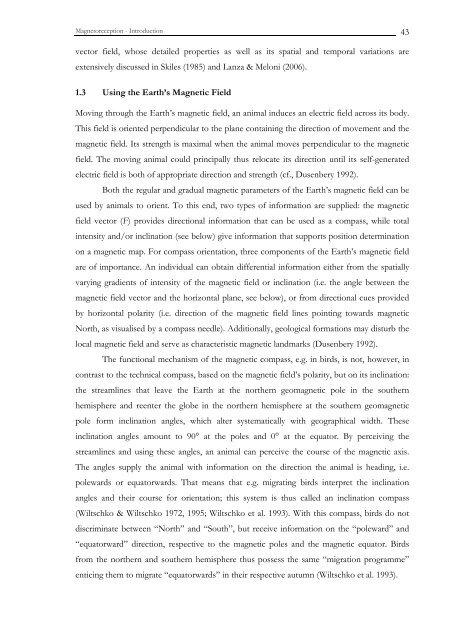Antigen Biotinylated Anti-Rabbit lgs Rabbit Primary Antiserum AB ...
Antigen Biotinylated Anti-Rabbit lgs Rabbit Primary Antiserum AB ...
Antigen Biotinylated Anti-Rabbit lgs Rabbit Primary Antiserum AB ...
Create successful ePaper yourself
Turn your PDF publications into a flip-book with our unique Google optimized e-Paper software.
Magnetoreception - Introduction<br />
vector field, whose detailed properties as well as its spatial and temporal variations are<br />
extensively discussed in Skiles (1985) and Lanza & Meloni (2006).<br />
1.3 Using the Earth’s Magnetic Field<br />
Moving through the Earth’s magnetic field, an animal induces an electric field across its body.<br />
This field is oriented perpendicular to the plane containing the direction of movement and the<br />
magnetic field. Its strength is maximal when the animal moves perpendicular to the magnetic<br />
field. The moving animal could principally thus relocate its direction until its self-generated<br />
electric field is both of appropriate direction and strength (cf., Dusenbery 1992).<br />
Both the regular and gradual magnetic parameters of the Earth’s magnetic field can be<br />
used by animals to orient. To this end, two types of information are supplied: the magnetic<br />
field vector (F) provides directional information that can be used as a compass, while total<br />
intensity and/or inclination (see below) give information that supports position determination<br />
on a magnetic map. For compass orientation, three components of the Earth’s magnetic field<br />
are of importance. An individual can obtain differential information either from the spatially<br />
varying gradients of intensity of the magnetic field or inclination (i.e. the angle between the<br />
magnetic field vector and the horizontal plane, see below), or from directional cues provided<br />
by horizontal polarity (i.e. direction of the magnetic field lines pointing towards magnetic<br />
North, as visualised by a compass needle). Additionally, geological formations may disturb the<br />
local magnetic field and serve as characteristic magnetic landmarks (Dusenbery 1992).<br />
The functional mechanism of the magnetic compass, e.g. in birds, is not, however, in<br />
contrast to the technical compass, based on the magnetic field’s polarity, but on its inclination:<br />
the streamlines that leave the Earth at the northern geomagnetic pole in the southern<br />
hemisphere and reenter the globe in the northern hemisphere at the southern geomagnetic<br />
pole form inclination angles, which alter systematically with geographical width. These<br />
inclination angles amount to 90° at the poles and 0° at the equator. By perceiving the<br />
streamlines and using these angles, an animal can perceive the course of the magnetic axis.<br />
The angles supply the animal with information on the direction the animal is heading, i.e.<br />
polewards or equatorwards. That means that e.g. migrating birds interpret the inclination<br />
angles and their course for orientation; this system is thus called an inclination compass<br />
(Wiltschko & Wiltschko 1972, 1995; Wiltschko et al. 1993). With this compass, birds do not<br />
discriminate between “North” and “South”, but receive information on the “poleward” and<br />
“equatorward” direction, respective to the magnetic poles and the magnetic equator. Birds<br />
from the northern and southern hemisphere thus possess the same “migration programme”<br />
enticing them to migrate “equatorwards” in their respective autumn (Wiltschko et al. 1993).<br />
43

















